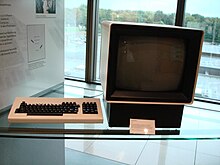| This article needs additional citations for verification. Please help improve this article by adding citations to reliable sources. Unsourced material may be challenged and removed. Find sources: "3M computer" – news · newspapers · books · scholar · JSTOR (November 2023) (Learn how and when to remove this message) |

The 3M computer industrial goal was first proposed in the early 1980s by Raj Reddy and his colleagues at Carnegie Mellon University (CMU) as a minimum specification for academic and technical workstations. It requires at least one megabyte of memory, a one megapixel display with 1024×1024 1-bit pixels, and one million instructions per second (MIPS) of processing power. It was also often said that it should cost no more than one "megapenny" or $10,000 (equivalent to $37,000 in 2023).
At that time, a typical desktop computer such as an early IBM Personal Computer might have 1/8 of a megabyte of memory (128K), 1/4 of a million pixels (640 × 400 monochrome display), and run at 1/3 million instructions per second (5 MHz 8088).
The concept was inspired by the Xerox Alto which had been designed in the 1970s at the Xerox Palo Alto Research Center. Several Alto workstations were donated to CMU, Stanford, and MIT in 1979. An early 3M computer is the PERQ Workstation made by Three Rivers Computer Corporation. It has a 1 million P-codes (Pascal instructions) per second processor, 256 KB of RAM (upgradeable to 1 MB), and a 768×1024 pixel display on a 15-inch (380 mm) display. Though not quite a true 3M machine, it was used as the initial 3M machine for the CMU Scientific Personal Integrated Computing Environment (SPICE) workstation project.
The Stanford University Network SUN workstation, designed by Andy Bechtolsheim in 1980, is another example. It was then commercialized by Sun Microsystems in 1982. Apollo Computer (in the Route 128 region) announced the Apollo/Domain computer in 1981. By 1986, CMU stated that it expected at least two companies to introduce 3M computers by the end of the year, with academic pricing of $3,000 and retail pricing of $5,000, and Stanford University planned to deploy them in computer labs. The first "megapenny" 3M workstation was the Sun-2/50 diskless desktop workstation with a list price of $8,900 in 1986.
The original NeXT Computer was introduced in 1988 as a 3M machine by Steve Jobs, who first heard this term at Brown University. The NeXT MegaPixel Display has just over 930,000 pixels with 2 bits per pixel. However, floating-point performance, powered with the Motorola 68882 FPU is only about 0.25 megaflops.
Modern desktop computers exceed the 3M memory and speed requirements by many thousands of times, however 1080p screen pixels are only 2 times larger and 4K 8 times larger, but they are full color so each pixel uses at least 24 times as many bits.
References
- Andries van Dam; David H. Laidlaw; Rosemary Michelle Simpson (August 4, 2002). "Experiments in Immersive Virtual Reality for Scientific Visualization". Computers & Graphics. 26 (4): 535–555. CiteSeerX 10.1.1.4.9249. doi:10.1016/S0097-8493(02)00113-9.
In the early 1980s Raj Reddy and his colleagues at CMU coined the term '3M Machine'.
- ^ A. Bechtolsheim; F. Baskett (July 1980). "High-performance raster graphics for microcomputer systems". ACM SIGGRAPH Computer Graphics. 14 (3). ACM SIGGRAPH: 43–47. doi:10.1145/965105.807466.
- 1990, Eric S. Raymond, megapenny, Jargon File 2.2.1 (June 12, 1990)
- (meg'a-pen'ee) n. $10,000 (1 cent * 10e6). Used semi-humorously as a unit in comparing computer cost/performance figures.
- Johnston, Louis; Williamson, Samuel H. (2023). "What Was the U.S. GDP Then?". MeasuringWorth. Retrieved November 30, 2023. United States Gross Domestic Product deflator figures follow the MeasuringWorth series.
- "PERQ History 1979: 3. Early Days". Atlas Computing Division Rutherford Laboratory. Chilton Computing. Archived from the original on June 13, 2011. Retrieved May 3, 2011.
- PERQ Publicity: ICL's PERQ Brochure, Chilton Computing, UK.
- PERQ Publicity: ICL's PERQ Leaflets 1985
- ^ Andreas Bechtolsheim; Forest Baskett; Vaughan Pratt (March 1982). The SUN Workstation Architecture (PDF). Stanford University Computer Systems Laboratory. Retrieved May 1, 2011. CSL Technical Report 229 (First author name is misspelled on cover)
- ^ AnnaLee Saxenian (December 9, 1994). "The Limits of Autarky: Regional Networks and Industrial Adaptation in Silicon Valley and Route 128". HUD Roundtable on Regionalism Sponsored by the Social Science Research Council. Retrieved May 3, 2011.
- Forbes, Jim (March 17, 1986). "Makers Ready '3M' Workstations". InfoWorld. p. 15. Retrieved February 20, 2015.
- Andy Hertzfeld (January 1983). "What's A Megaflop?". Macintosh Stories. folklore.org. Retrieved January 26, 2008.
- NeXT User's Reference, 4/90, pg. 242, Reorder Product #N6002
- "NeXT Computer | Science Museum Group Collection". collection.sciencemuseumgroup.org.uk. Retrieved August 17, 2024.
